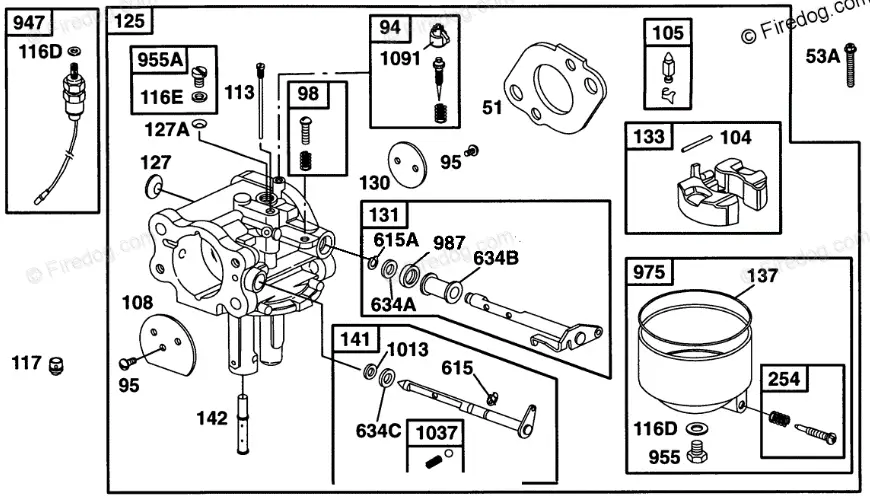One of the most critical components in the engines is the carburetor, which plays a crucial role in mixing air and fuel to ensure proper combustion. Understanding the Briggs and Stratton carburetor diagram can help users troubleshoot issues, maintain their equipment, and even replace parts when necessary.
In this post, we will explore the Briggs and Stratton carburetor diagram, explain its components and their functions, and provide insight into how this small but vital engine part works.
Briggs and Stratton Carburetor Diagram
A carburetor diagram visually represents the different parts of the carburetor, showing how they connect and function together. It helps technicians and DIY enthusiasts identify components and diagnose potential issues.
The carburetor typically consists of several key components, including:
- Float Bowl
- Needle Valve and Seat
- Main Jet and Idle Jet
- Choke Plate and Throttle Plate
- Fuel Inlet and Fuel Line
- Air-Fuel Mixture Screw
Each of these parts plays a role in ensuring that the engine receives the right amount of fuel and air for smooth operation.
Key Components of a Briggs and Stratton Carburetor

Check Your Carburetor Parts HERE
1. Float Bowl
The float bowl is a small reservoir that stores fuel before it is mixed with air. It contains a float that regulates the fuel level, ensuring a steady supply to the carburetor.
2. Needle Valve and Seat
The needle valve controls the fuel flow into the float bowl. When the float rises, it pushes the needle valve into its seat, cutting off fuel supply to prevent overflow.
3. Main Jet and Idle Jet
- The main jet controls fuel delivery at higher RPMs.
- The idle jet manages fuel flow at lower RPMs.
Both jets play a crucial role in maintaining the engine’s performance under different load conditions.
Related Briggs and Stratton Auto Choke Bypass(Choke No More)
4. Choke Plate and Throttle Plate
- The choke plate restricts airflow to create a richer fuel mixture, aiding in cold starts.
- The throttle plate controls the amount of air entering the carburetor, which in turn regulates engine speed.
5. Fuel Inlet and Fuel Line
The fuel inlet connects the carburetor to the fuel tank through a fuel line, allowing a steady flow of gasoline into the system.
6. Air-Fuel Mixture Screw
This screw fine-tunes the ratio of air to fuel entering the combustion chamber, optimizing performance and fuel efficiency.
Related How to Adjust Governor on Briggs and Stratton(In 7 Easy Steps)
How a Briggs and Stratton Carburetor Works
1. Fuel Enters the Float Bowl
- Fuel is drawn from the fuel tank into the float bowl.
- The float maintains a stable fuel level, ensuring a consistent supply.
2. Air is Drawn into the Carburetor
- As the engine runs, air is pulled in through the air intake.
- The throttle plate regulates the volume of air entering the system.
3. Fuel Mixes with Air
- The main jet and idle jet deliver the appropriate amount of fuel.
- The mixture is adjusted using the air-fuel mixture screw.
4. Fuel-Air Mixture is Sent to the Combustion Chamber
- The mixture is atomized and sent into the cylinder, where it ignites and powers the engine.
5. Choke Aids Cold Starts
- When the engine is cold, the choke plate restricts airflow to create a richer mixture, making ignition easier.
Related Briggs and Stratton Leaking Oil From Bottom(5 Causes and Solutions)
Common Carburetor Issues and Troubleshooting
1. Engine Won’t Start or Runs Rough
- Possible Causes: Clogged jets, stuck float, incorrect air-fuel mixture.
- Solution: Clean the carburetor and adjust the air-fuel mixture screw.
2. Fuel Leaking from the Carburetor
- Possible Causes: Faulty float needle valve, cracked fuel line, or worn gaskets.
- Solution: Replace damaged parts and inspect for leaks.
3. Engine Surging or Stalling
- Possible Causes: Dirty carburetor, improper fuel supply, or vacuum leaks.
- Solution: Clean the jets and check for blockages in fuel lines.
4. Black Smoke from Exhaust
- Possible Causes: Too much fuel in the mixture (rich condition).
- Solution: Adjust the air-fuel mixture screw to allow more air.
Related Briggs and Stratton Engine Bogs Down Under Load(Solved)
Maintaining a Briggs and Stratton Carburetor
1. Regular Cleaning
- Use carburetor cleaner to remove dirt and varnish buildup.
- Disassemble and soak small parts if necessary.
2. Replace Worn-Out Parts
- Check gaskets, seals, and fuel lines for wear and replace them.
- Ensure the needle valve and float move freely.
3. Use Clean, Fresh Fuel
- Stale fuel can lead to clogging and poor engine performance.
- Use fuel stabilizers if storing equipment for a long period.
4. Adjust Air-Fuel Mixture Properly
- Fine-tune the air-fuel mixture screw for optimal performance.
- Refer to the carburetor diagram to locate the adjustment points.
Related Briggs and Stratton Blowing Oil Out Exhaust(Causes and Solutions)
FAQ
How do you adjust the mixture on a Briggs and Stratton carburetor?
To adjust the air-fuel mixture on a Briggs and Stratton carburetor:
- Locate the adjustment screw(s): Most carburetors have an idle mixture screw and a main mixture screw.
- Turn the screw(s):
- To enrich the mixture (more fuel), turn the screw counterclockwise.
- To lean the mixture (more air), turn the screw clockwise.
- Start the engine and let it warm up: Adjust the screws gradually while listening for smooth running.
- Fine-tune: Adjust until the engine runs smoothly without hesitation or excessive smoke.
Where do the springs go on a Briggs and Stratton carburetor?
Briggs and Stratton carburetors have various springs that control throttle movement and governor function:
- Throttle return spring: Connects between the throttle linkage and carburetor to help return the throttle to idle.
- Governor spring: Attaches between the governor arm and throttle linkage to regulate engine speed.
- Choke spring: Helps return the choke plate to the open position after starting.
Related Briggs and Stratton V Twin Governor Problems (3 Issues and Solutions)
What does a Briggs and Stratton carburetor do?
A carburetor in a Briggs and Stratton engine:
- Mixes air and fuel in the correct ratio.
- Delivers the mixture to the combustion chamber for ignition.
- Adjusts the mixture based on engine speed and load.
- Ensures smooth running, efficient fuel consumption, and proper power output.
Can you clean a Briggs and Stratton carburetor without removing it?
Yes, but it may not be as effective as a full disassembly. Here’s how:
- Turn off the engine and remove the air filter.
- Spray carburetor cleaner into the air intake and throttle area.
- Manually operate the throttle and choke to help cleaner flow through.
- Start the engine and spray cleaner into the carburetor while running.
- Let it run for a few minutes to clear out debris.
For deeper cleaning, disassembly is recommended.
Related John Deere Mower Blade Torque Specs(The Ultimate Guide)
How do you adjust air-fuel mixture screws in the carburetor?
To adjust the air-fuel mixture screws:
- Turn the screws all the way in (gently) to seat them.
- Back them out 1 to 1.5 turns as a starting point.
- Start the engine and let it warm up.
- Turn the screws in small increments to find the smoothest running condition.
- Check acceleration and idle: The engine should run smoothly without sputtering or bogging down.
How do you balance the air and fuel ratio on a carburetor?
Balancing the air-fuel ratio involves:
- Adjusting the idle mixture screw to get a steady idle.
- Tuning the main jet (if applicable) for proper fuel flow at higher speeds.
- Ensuring the governor and throttle linkage are set correctly.
- Checking for vacuum leaks that could affect the mixture.
- Testing under load: Adjust if necessary to prevent excessive smoke or rough running.
Related Briggs and Stratton 21 HP Platinum Engine Problems(With Solutions)
Final word
The carburetor ensures that the correct balance of fuel and air reaches the engine, allowing it to run efficiently. By familiarizing yourself with the components and how they work together, you can troubleshoot issues, maintain your engine, and even replace parts when needed.




